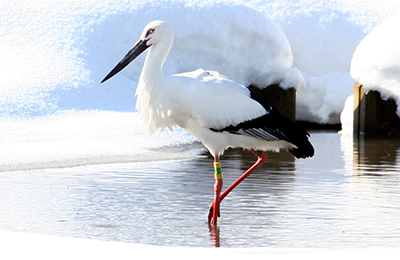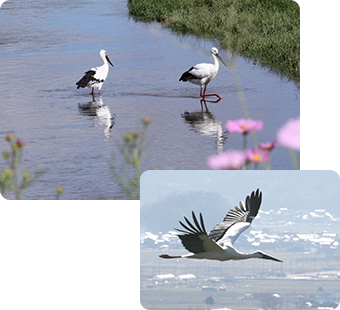| EDO period |
There are records that oriental white storks were distributed all over the country.
|
| MEIJI period
|
As ordinary people became able to hunt, oriental white storks were over-hunted and the number of individuals declined.
|
| 1921
|
"Tsuruyama" in Izushi-cho, Izushi-gun, Hyogo Prefecture, was designated as a national natural monument as a breeding ground of oriental white storks.
|
| 1939-1945 |
Tall pine trees suitable for oriental white stork nesting were cut down, and the number of nesting sites reduced.
|
| 1950s and 1960s |
Prey animals and the storks that feed on them were negatively affected by the use of potent pesticides and environmental changes, and the wild oriental white stork population declined in size.
|
| 1952
|
"The oriental white stork and its breeding area of Iza" in Iza-mura, Yabu-gun, Hyogo Prefecture, was designated as a national special natural monument.
|
| 1953
|
The designation of the national special natural monument for the oriental white stork was changed from "area-type" to "species itself."
|
| 1955-1964
|
To conserve the ever-declining oriental white stork population, public and private conservation activities such as the "gentle watching campaign" and the "one person-one loach campaign" were developed. However, the population size continued to decline.
|
| 1965
|
One wild pair was captured in Toyooka City, Hyogo Prefecture, on February 11, to preserve the wild stork population, which had decreased to 12 birds in total. Captive breeding started in the Stork Breeding Center (Current: Oriental White Stork Captive Breeding Center affiliated to Hyogo Park of the Oriental White Stork).
|
| 1971
|
The last wild oriental white stork died after being rescued in Toyooka City, Hyogo Prefecture, and the breeding population of the oriental white stork in Japan went extinct.
|
| 1988
|
Tama Zoological Park succeeded in breeding oriental white storks for the first time in Japan.
|
| 1989
|
The Stork Breeding Center in Hyogo Prefecture also succeeded in breeding oriental white storks.
|
| 1990
|
The Japanese Association of Zoos and Aquariums (JAZA) started the Japanese studbook registration for oriental white storks reared all over Japan.
|
| 1995
|
The World Association of Zoos and Aquariums (WAZA) started the international studbook registration for oriental white storks reared all over the world.
|
| 1999
|
Hyogo Park of the Oriental White Stork was established by Hyogo Prefecture aiming at reintroducing oriental white storks into the wild.
Fertilized eggs were successfully transported from Tama Zoological Park in Tokyo to Korea National University of Education.
|
| 2002
|
Captive population size reared in Hyogo Park of the Oriental White Stork exceeded 100.
|
| 2005
|
Hyogo Park of the Oriental White Stork released five oriental white storks into the wild (reintroduction started).
|
| 2007
|
The first breeding success in the wild was recorded on an artificial nest tower in Toyooka City, Hyogo Prefecture.
|
| 2013
|
IPPM-OWS was established.
|
| 2015
|
Fukui Prefecture and Noda City (Chiba Prefecture) started reintroduction projects. Reintroduction also started in South Korea.
|
| 2017
|
Successful breeding was recorded for the first time in Tokushima Prefecture, outside the northern part of Kinki District (Toyooka City, Hyogo Prefecture, and Kyotango City, Kyoto Prefecture). In addition, the wild population size exceeded 100, and observation records of the reintroduced storks was achieved in all prefectures of Japan, in 12 years after the start of the reintroduction.
|
| 2020
|
The wild stork population size exceeded 200.
|
| 2022
|
The wild Oriental White stork population size exceeded 300.Breeding of Oriental White storks are observed in seven prefectures in Japan. |


